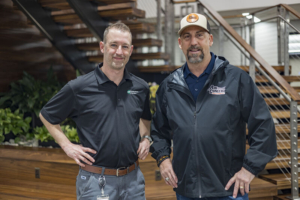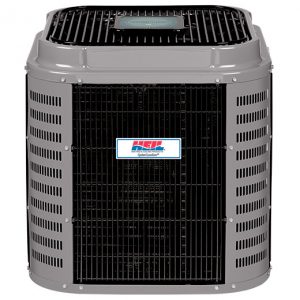test
Add some text to test this.
Add some text to test this.
 While performing a routine energy audit, we head off a potentially dangerous issue. We joined Energy Specialist Josh Laughter with Berkeley Electric to investigate a high electric bill. The owner of the home was paying around $500 a month during the cold season and Josh deduced there was a possible problem with their HVAC system. We visited the member’s home together to take a closer look and found that the thermostat had been wired incorrectly.
While performing a routine energy audit, we head off a potentially dangerous issue. We joined Energy Specialist Josh Laughter with Berkeley Electric to investigate a high electric bill. The owner of the home was paying around $500 a month during the cold season and Josh deduced there was a possible problem with their HVAC system. We visited the member’s home together to take a closer look and found that the thermostat had been wired incorrectly.
We found melted wires in the air handler and when the HVAC unit was cut on a small fire occurred. Thankfully, we were on-site to see the fire and were able to extinguish it quickly. We disconnected the heat strips to prevent further problems. Not only did we fix the thermostat and heat strips but now the member’s bill has dropped from $500 a month to around $100-$150.
We tend to think that we can set our air conditioning thermostats to whatever temperature we desire and have the air conditioner do its job no matter what.
However, this is not the case. There is a limit to how much an air conditioner can realistically cool when comparing temperature differences between inside and outside air. Air Concept Solutions, LLC is an air conditioning company that understands the limits of various AC systems and can prevent you from needlessly running your air conditioner too much on the hottest days so you make the most efficient use of your air conditioning.
Temperature Differences between Inside and Outside Air
ASHRAE (American Society of Heating, Refrigerating and Air-Conditioning Engineers, Inc.) has designated realistic cooling parameters for air conditioner systems. Generally speaking an air conditioning system is designed to accommodate up to a 20 degree difference between the outside air and inside air while still keeping around a 55% humidity level which is comfortable. This means that if it is 80 outside your AC can easily reach 70 degrees, since that is only a 10 degree temperature difference.
So even if it is 90 degrees out your air conditioner should still easily reach the 70 degree mark. However, if it is 100 degrees outside, it will be nearly impossible to reach 70 degrees inside without the air conditioner working overtime and causing problems such as excess humidity.
 Most air conditioning systems are not designed to keep your home as cool as 75 degrees on extreme heat days for a reason. In order to accomplish this on a regular basis your AC system would need to be much larger and you would be paying for much more AC system than you typically need which would significantly increase your energy bills. If you have your air conditioner set to a temperature that makes that differential more than twenty degrees you will likely run your AC all day long and still not quite reach those desired temperatures. For typical home users this becomes a waste of money on your end as you overuse a system that was not designed to accommodate a more extreme change in temperature cooling.
Most air conditioning systems are not designed to keep your home as cool as 75 degrees on extreme heat days for a reason. In order to accomplish this on a regular basis your AC system would need to be much larger and you would be paying for much more AC system than you typically need which would significantly increase your energy bills. If you have your air conditioner set to a temperature that makes that differential more than twenty degrees you will likely run your AC all day long and still not quite reach those desired temperatures. For typical home users this becomes a waste of money on your end as you overuse a system that was not designed to accommodate a more extreme change in temperature cooling.
A good rule of thumb is during the hottest days when the dial reaches 100 degrees it is best to set your AC to somewhere between 75 and 80 degrees. You can also supplement that slight temperature difference with closed curtains on the sunny side of the building, running ceiling fans and portable fans in rooms where people are present, and keeping a tall glass of ice water on-hand.
Energy Efficient AC
So you can see that bigger is not always better and over sizing your HVAC systems can cause more issues within your home. We can help you with high humidity issues, sweating ductwork, cooling and heating issues for a complete whole house approach to resolving your temperature issues. Additionally, make certain that your AC is properly maintained in order to eliminate the possibility of lost cooling efficiency and money through items which could have been easily fixed like replacing dirty filters and cleaning coils. Fresh filters and cleaning coils improve air flow and cooling efficiency.
At Air Concept Solutions, LLC. are here to help you inspect, diagnose, service and repair your ac systems or problems properly.
Call Us Today: (843)376-7214
More about air conditioning >>
There is a lot to know about the scheduled freon phaseout and how it affects consumers. It’s important to be informed so that you know how your systems are affected, the laws pertaining to freon use and how to make sure you are in compliance with the law. Click on any link below to read more:
 Air Concept Solutions is now recognized as a participating employer for the Youth Apprenticeship program in Charleston. We hire high school students that qualify for the program under their guidelines, then train them on the job while adhering to training literature of our choosing. The program can go up to 2 years, sometimes three. We work with college students to help teach young people to earn an education. This is a really valuable learning program for students interested in learning the HVAC trade and we love working with them. For more information, click on the brochure on the right or contact us here on the site and we’d be happy to talk more with you about these learning opportunities.
Air Concept Solutions is now recognized as a participating employer for the Youth Apprenticeship program in Charleston. We hire high school students that qualify for the program under their guidelines, then train them on the job while adhering to training literature of our choosing. The program can go up to 2 years, sometimes three. We work with college students to help teach young people to earn an education. This is a really valuable learning program for students interested in learning the HVAC trade and we love working with them. For more information, click on the brochure on the right or contact us here on the site and we’d be happy to talk more with you about these learning opportunities.
In my years in the trade I have always had that question by the customer. Why does my thermostat read 75 degrees but it does not feel like 75 degreesThe first thing is not to confuse temperature with humidity.
Humidity is something we hear about daily in weather reports. Humidity is the blame for that muggy, steam-room feeling experienced on certain summer days. Humidity can be measured in several ways, but relative humidity is the most common. In order to understand relative humidity, it is helpful to first understand absolute humidity.
Absolute humidity is the mass of water vapor divided by the mass of dry air in a volume of air at a given temperature. The hotter the air is, the more water it can contain.
Relative humidity is the ratio of the current absolute humidity to the highest possible absolute humidity ( which depends on the current air temperature ). A reading of 100 percent relative humidity means that the air is totally saturated with water vapor and cannot hold any more water vapor.
Individuals are very sensitive to humidity; the body relies on the evaporation of sweat to provide cooling for the body. The process of sweating is the body’s attempt to keep cool and maintain its current temperature. If the air is at 100-percent relative humidity, sweat will not evaporate into the air. As a result, a person may feel much hotter than the actual temperature when the relative humidity is high. If the relative humidity is low, we feel much cooler than the actual temperature because our sweat evaporates easily and cools us off.
People tend to feel most comfortable at a relative humidity of about 45%.
To avoid any mold problems, the indoor humidity should always be maintained below 55% (ideally between 30% and 50% ) relative humidity is recommended for comfort.
There are many different types and brands of dehumidifiers used to control moisture in crawlspace areas.
Have you ever experienced any of the following uncomfortable and/or unhealthy conditions:
1. Do you have trouble sleeping at night due to clammy skin or stuffiness in the air?
2. Have you ever reduced the temperature setting because you’re uncomfortable with the stuffy feeling?
3. Have your floors or other surfaces ever felt sticky or sweaty?
4. Are you concerned with mold and mildew growth in your home?
5. Do you have musty odors or smells in any area of your home?
6. Do you have condensation on your water pipes?
7. Have you seen wet stains on walls or ceilings?
8. Do you or a family member have allergies (over-moist air can encourage the growth of mold, bacteria, and dust mites, three commonly known household allergens).
9. Experiencing any of the above conditions can make sleeping and even daily activities miserable plus some conditions can be hazardous to your family’s health or your home’s furnishings.
10. Do you tend to get sick more offend that expected?
Did you know?
That dust mites (and their waste products) are one of the most common triggers for allergies and asthma? The Environmental Protection Agency advises keeping your home’s relative humidity between 30-50% to avoid dust mite infestation.
Please call us today to help you resolve your humidity and crawlspace issues.
Mini Split is another name for a ductless heating and cooling system that can both be designed for the use of straight air cooling or as a heatpump system that can perform heating and cooling. They are especially desirable for remote rooms and rooms with special HVAC needs in which additional ductwork may not be sufficient or accessible. One example is a finish room over a garage in which some call a (FROG). Ductless Mini Splits are also used when a garage or a porch area become enclosed into a finished living area. Communication or computer rooms can also benefit when it is important and required to maintain lower room temperatures.
Ductless Mini Splits have several advantages and can be used in many applications when cost matters. In the examples giving above, the overall cost for installation is nearly lower in every case. With its wireless thermostat capabilities it gives excellent temperature control. Over the years efficiency of theses units have risen dramatically with the new inverted technology. Mini Split equipment uses minimal amp draw and wattage often exceeding that of a fully ducted system.
Air Concept Solutions offers many major brands with full equipment warranty; please contact our office to learn more about how you can benefit and set up your free inspection quote today.
We offer:
 Nowadays with the ease of purchasing online, many customers may try to save money by buying their own equipment online. It is very important to understand that this type of online purchase may void any kind of warranty you would have on that expensive equipment. Online sellers are not licensed vendors and in many cases, the manufacturer is not obligated to honor the warranty. Please be sure to download and read our helpful notice on HVAC Manufacturing & Selling Policy Concerning Online Sales to Consumers so that you don’t lose out.
Nowadays with the ease of purchasing online, many customers may try to save money by buying their own equipment online. It is very important to understand that this type of online purchase may void any kind of warranty you would have on that expensive equipment. Online sellers are not licensed vendors and in many cases, the manufacturer is not obligated to honor the warranty. Please be sure to download and read our helpful notice on HVAC Manufacturing & Selling Policy Concerning Online Sales to Consumers so that you don’t lose out.
Download Our HVAC Manufacturing & Selling Policy Concerning Online Sales to Customers >>
In several regions of the United States, powered attic ventilators enjoy the pleasures of a positive reputation. They are promoted by builders, shingle manufactures, roofers, HVAC contractors, utilities, weekender material retailers, ventilation manufactures, consultants and others. Extending shingle life, protecting shingle warrantee, removing moisture from attics and reducing the air conditioning load by the removal of attic heat are their believed benefits. These regional cultures accept and sometimes expect the use of powered attic ventilators. Cash flow in their regional economic systems is saturated with their use. Those who manufacture sell or install powered attic ventilators in these regional cultures could experience financial hardships should it be suggested that powered roof ventilators should not be used. However, that is our central theme as a result of our measurements of some of their unplanned impacts on houses.
A review of some of the important issues Attic Ventilator’s & the problems they can cause in your home includes the following:
What really happens is that when that power attic ventilator runs, it’s going to pull air from wherever it can find it. Since air takes the path of least resistance, some of it will most likely be coming from the conditioned space in your home. So basically what you’re doing is air conditioning your attic. The longer the fan runs the more conditioned air it pulls into the attic.
If you have a perfectly air-sealed ceiling, you’re not going to have this problem, of course. The reality, however, is that few ceilings are leak-free. Since air needs only a pressure difference and a pathway to move, and your ceiling probably has plenty of pathways, it’s best not to enhance any pressure differences that will increase air movement into or out of your home. Air sealing & tighten is key along with changing the overall environmental conditions. With properly sized dehumidifiers you can remove the moisture and condition your space keeping it nice and dry without bringing high humid air moisture back in.
In other words, don’t install that power attic ventilator. If you have some installed already, disable them so they never run.
Power attic ventilators can cause problems even without air conditioning. One potential problem would be sucking moist, moldy air up from the crawl space into the house.
Another would be backdrafting a water heater and putting carbon monoxide in the house. These are real problems from real houses that have really happened.
The first step before investing in an Attic Ventilator is to have your home properly assisted by a certified Home Energy Auditor to see at a minimum, if you are a good candidate. Don’t be fooled by fast talking salesman that hide the truth when it comes to the negative issues attic ventilators can cause to your home. It is Key that you have the whole house approach before jumping to this so called quick fix. Having a Home Energy Audit, Blower door Test & Duct Testing can be some methods to properly examine & resolve your homes infiltration issues. By locating infiltration and improving the tightness in your home you can increase your comfort and save on your overall energy consumption. It is recommended that if a powered attic ventilator is chosen as part of an attic ventilation strategy, the following guidelines should be provided. Make sure you are a good candidate. The installer should provide a good air barrier between the house and the attic and adequate, net free, vent area should be provided. Confirmation of safe operation is provided by measuring not by ignoring, guessing, or hoping.
Please Call Air Concept Solutions, LLC Today to learn more and schedule a free assessment.
The most important thing you can check yourself is the filter. A dirty filter can cause extra strain on your heating equipment, raise heating costs and shorten the life of your furnace. Make sure your filter has a cover over the slot that returns the air. If the furnace filter does not have a cover over the slot this can be a serious safety hazard.
If your system has pleated filters, these usually can last up to three months. If your filters are permanent, you should try to clean these once a month, especially during high use seasons. Electronic air filters can usually be checked every 2 months.
Remember, your best assurance for the longevity of your heating equipment is to do at least yearly inspections with a heating and cooling professional. Keeping your filters clean is one thing you can do to enhance the operation and life of your system.
As always, you can contact us with questions about your furnace or to do furnace maintenance.
